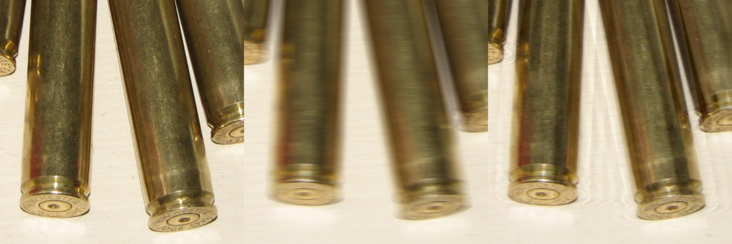- Motion blur
-
Motion blur is the apparent streaking of rapidly moving objects in a still image or a sequence of images such as a movie or animation. It results when the image being recorded changes during the recording of a single frame, either due to rapid movement or long exposure.
Contents
Applications of motion blur
Photography
When a camera creates an image, that image does not always represent a single instant of time. Because of technological constraints or artistic requirements, the image may represent the scene over a period of time. As objects in a scene move, an image of that scene must represent an integration of all positions of those objects, as well as the camera's viewpoint, over the period of exposure determined by the shutter speed. In such an image, any object moving with respect to the camera will look blurred or smeared along the direction of relative motion. This smearing may occur on an object that is moving or on a static background if the camera is moving. In a film or television image, this looks natural because the human eye behaves in much the same way.
 Early example of motion blur
Early example of motion blur
Because the effect is caused by the relative motion between the camera, and the objects and scene, motion blur may be avoided by panning the camera to track those moving objects. In this case, even with long exposure times, the objects will appear sharper, and the background more blurred.
Animation
In computer animation (2D or 3D) it is computer simulation in time and/or on each frame that the 3D rendering/animation is being made with real video camera during its fast motion or fast motion of "cinematized" objects or to make it look more natural or smoother.
Without this simulated effect each frame shows a perfect instant in time (analogous to a camera with an infinitely fast shutter), with zero motion blur. This is why a video game with a frame rate of 25-30 frames per second will seem staggered, while natural motion filmed at the same frame rate appears rather more continuous. Many next generation video games feature motion blur, especially vehicle simulation games.
Some of the more known games that utilise this are the recent Need for Speed titles, Unreal Tournament III, The Legend of Zelda: Majora's Mask and many others. When used in videogames, there are generally two methods used to achieve motion blur: cheaper full-screen effects, which typically only take camera movement (and sometimes how fast the camera is moving in 3-D Space to create a radial blur) into mind, and more "selective" or "per-object" motion blur, which typically uses a shader to create a velocity buffer to mark motion intensity for a motion blurring effect to be applied to or uses a shader to perform geometry extrusion.
In pre-rendered computer animation, such as CGI movies, realistic motion blur can be drawn because the renderer has more time to draw each frame. Temporal anti-aliasing produces frames as a composite of many instants.
Motion lines in cel animation are drawn in the same direction as motion blur and perform much the same duty. Go motion is a variant of stop motion animation that moves the models during the exposure to create a less staggered effect.
Computer graphics
In 2D computer graphics, motion blur is an artistic filter that converts the digital image[1]/bitmap[2]/raster image in order to simulate the effect. Many graphical software products (e.g. Adobe Photoshop or GIMP) offer simple motion blur filters. However, for advanced motion blur filtering including curves or non-uniform speed adjustment, specialized software products are necessary.[3]
Biology
When an animal's eye is in motion, the image will suffer from motion blur, resulting in an inability to resolve details. To cope with this, humans generally alternate between saccades (quick eye movements) and fixation (focusing on a single point). Saccadic masking makes motion blur during a saccade invisible. Similarly, smooth pursuit allows the eye to track a target in rapid motion, eliminating motion blur of that target instead of the scene.
Negative effects of motion blur
In televised sports, where conventional cameras expose pictures 25 or 30 times per second, motion blur can be inconvenient because it obscures the exact position of a projectile or athlete in slow motion. For this reason special cameras are often used which eliminate motion blurring by taking rapid exposures on the order of 1/1000 of a second, and then transmitting them over the course of the next 1/25 or 1/30 of a second. Although this gives sharper slow motion replays it can look strange at normal speed because the eye expects to see motion blurring and does not.
Sometimes, motion blur can be removed from images with the help of deconvolution.
Restoration
An example of blurred image restoration with Wiener deconvolution:
References
- ^ Motion Blur Effect, TutorialsRoom
- ^ Photoshop - Motion Blur, tizag.com
- ^ Traditional motion blur methods, virtualrig-studio.com
Gallery
-
Motion blur is frequently employed in sports photography (particularly motor sports) to convey a sense of speed. To achieve this effect it is necessary to use a slow shutter speed and pan the lens of the camera in time with the motion of the object
-
Strickland Falls in Tasmania, Australia, taken using a neutral density filter. ND filters reduce light of all colors or wavelengths equally, allowing an increase in aperture and decrease in shutter speed without overexposing the image. To create the motion blur seen here, the shutter must be kept open for a relatively long time, making it necessary to reduce the amount of light coming through the lens.
Categories:- Science of photography
- Photographic techniques
- Animation techniques
Wikimedia Foundation. 2010.








